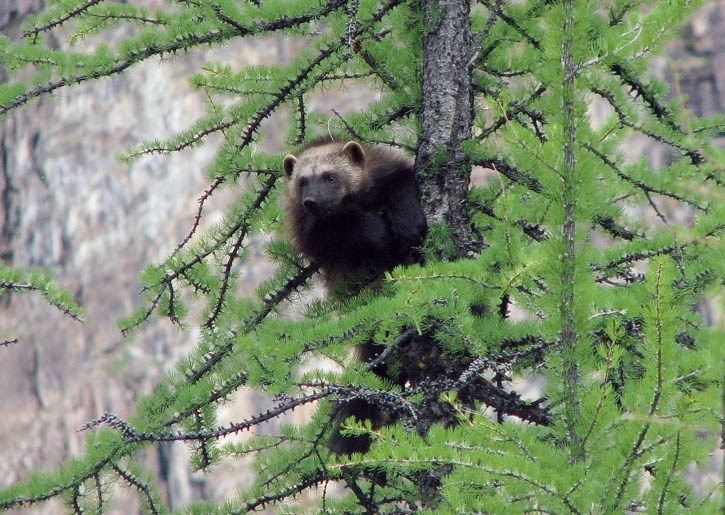Continued monitoring of wolverines in Banff National Park is a key recommendation of a leading wildlife crossing structure expert in a bid to learn more about the wide-ranging animals and their needs.
Tony Clevenger, a research wildlife scientist at the Western Transportation Institute-Montana State University, recommends Parks Canada continue long-term monitoring of underpasses and overpasses on Trans-Canada Highway.
To keep a closer eye on wolverines, he said, attention should be paid to Phase 3B crossings west of Castle Junction, noting the highway enters subalpine habitats of prime importance to wolverines as it moves up Banff’s Bow Valley towards the Continental Divide.
Monitoring should be conducted in conjunction with winter roadside surveys to help understand the number of highway crossings by wolverines not detected at crossing structures, breaches in fences and behaviour from snow tracking in the highway corridor.
Clevenger also said Parks should consider snow tracking to collect hair from wolverines that use wildlife structures. Gender information can be used to evaluate different crossing types and determine preferred designs for increasing female movement across the highway.
“It’s really important for Parks Canada to continue monitoring and 10 years is probably what’s required, given the current lack of information on this species,” said Clevenger, a Bow Valley-based scientist who led the crossing structure monitoring from 1996 to 2014.
“The last phase – phase 3B – is going into a completely different ecosystem. We’re really talking about the Continental Divide. We’re talking about wolverines. This is a pretty unique opportunity to start learning about wolverines and how they respond to highways.”
Banff National Park is home to six overpasses and 38 underpasses from the east gate of Banff National Park to the Alberta-B.C. border – the most wildlife crossing structures for any single stretch of highway anywhere in the world.
Animals need to cross the busy four-lane highway to search out mates, food, shelter and, in some cases, to escape predators. The structures are used by bears, wolves, coyotes, cougars, moose, elk, deer, bighorn sheep and, more recently, by lynx and wolverine.
Clevenger led the research and monitoring of Banff’s crossings structures for 17 years on a contract basis until Parks Canada decided to bring the monitoring program in-house last year. A spokesperson for Parks Canada was not available at press time.
Wolverines have been detected using the crossing structures only 10 times. A wolverine was documented using an overpass – the Wolverine overpass –- for the first time in November 2011.
Part of Clevenger’s research aimed to collect information on wolverine occurrence in the Canadian Rocky Mountains and examine whether transportation corridors affect their movements and gene flow.
The study covered an 8,000 square kilometer area of Banff, Yoho and Kootenay National Parks, as well as a part of the Columbia Valley near Golden, B.C.
To sample wolverines, skinned beaver carcasses were nailed to trees and secured with wire, luring wolverines to climb the tree and leave a hair sample. Remote infrared cameras at each site captured snapped thousands of photos of wolverine activity and behaviour.
A total of 2,563 hair samples were collected between 2010 and 2013. A total of 64 unique individuals – 25 females and 39 males – were detected. This, however, is not a population estimate. Seven of those animals crossed the highway.
Clevenger said many female and male wolverines include their home ranges in the study area, but the two sexes were affected differently by transportation infrastructure.
“We detected ample male movement across the TCH and a lack of genetic differentiation,” he said.
“However, we detected relatively strong genetic differentiation in females on either side of the TCH. We detected seven wolverines that crossed the TCH – two females, five males – possibly one of the females at a wildlife crossing structure.”
Clevenger said evidence suggests females may be starting to use wildlife crossings. For example, a female wolverine, F015, may have been the wolverine detected crossing northward at Castle underpass in February 2011.
The recommendations were part of the Trans-Canada Highway Wildlife Monitoring and Research final report by the Western Transportation Institute at Montana State University and Miistakis Institute
The wolverine and lynx part of the research project was branded “Highway Wilding” and partners included Parks Canada Agency, Western Transportation Institute – Montana State University, Miistakis Institute, Woodcock Foundation, and Wilburforce Foundation.
Wolverines are fierce and feisty and live in some of the most extreme alpine and subalpine environments. Federally, the wolverine is listed as a species of special concern, while in Alberta it is listed as data deficient.
Loss of habitat and barriers to movement, along with continuing warming climate, are recognized as threats that further diminish and fragment the critical landscapes wolverines need.
In both B.C. and Alberta, wolverines are under pressure from recreational activities, transportation, and oil and gas development.
“Recent research in central Alberta suggests that national parks may be a source population for unprotected areas in British Columbia and Alberta,” according to the final report on crossing structure monitoring.




